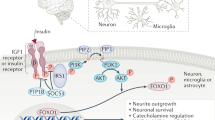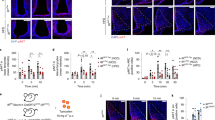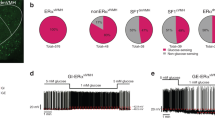Abstract
Circulating insulin inhibits endogenous glucose production. Here we report that bidirectional changes in hypothalamic insulin signaling affect glucose production. The infusion of either insulin or a small-molecule insulin mimetic in the third cerebral ventricle suppressed glucose production independent of circulating levels of insulin and of other glucoregulatory hormones. Conversely, central antagonism of insulin signaling impaired the ability of circulating insulin to inhibit glucose production. Finally, third-cerebral-ventricle administration of inhibitors of ATP-sensitive potassium channels, but not of antagonists of the central melanocortin receptors, also blunted the effect of hyperinsulinemia on glucose production. These results reveal a new site of action of insulin on glucose production and suggest that hypothalamic insulin resistance can contribute to hyperglycemia in type 2 diabetes mellitus.
This is a preview of subscription content, access via your institution
Access options
Subscribe to this journal
Receive 12 print issues and online access
We are sorry, but there is no personal subscription option available for your country.
Buy this article
- Purchase on SpringerLink
- Instant access to full article PDF
Prices may be subject to local taxes which are calculated during checkout




Similar content being viewed by others
References
Taylor, S.I. Deconstructing type 2 diabetes. Cell 97, 9–12 (1999).
Sindelar, D.K. et al. Basal hepatic glucose production is regulated by the portal vein insulin concentration. Diabetes 47, 523–529 (1998).
Boden, G., Chen, X., Ruiz, J., White, J.V. & Rossetti, L. Mechanisms of fatty acids induced inhibition of glucose uptake. J. Clin. Invest. 93, 438–446 (1994).
Lewis, G.F., Vranic, M., Harley, P. & Giacca, A. Fatty acids mediate the acute extrahepatic effects of insulin on hepatic glucose production in humans. Diabetes 46, 111–119 (1997).
Rebrin, K., Steil, G.M., Getty, L. & Bergman, R.N. Free fatty acid as a link in the regulation of hepatic glucose output by peripheral insulin. Diabetes 44, 1038–1045 (1995).
Rebrin, K., Steil, G.M., Mittelman, S.D. & Bergman, R.N. Causal linkage between insulin suppression of lipolysis and suppression of liver glucose output in dogs. J. Clin. Invest. 98, 741–749 (1996).
Sindelar, D.K. et al. The role of fatty acids in mediating the effects of peripheral insulin on hepatic glucose production in the conscious dog. Diabetes 46, 187–196 (1997).
Woods, S.C., Lotter, E.C. & Porte, D. Jr. Chronic intracerebroventricular infusion of insulin reduces food intake and body weight of baboons. Nature 282, 503–505 (1979).
Woods, S.C., Seeley, R.J., Porte, D.J. & Schwartz, M.W. Signals that regulate food intake and energy homeostasis. Science 280, 1378–1383 (1998).
Davies, S.N. et al. Evidence that the brain of the conscious dog is insulin sensitive. J. Clin. Invest. 95, 593–602 (1995).
Williams, P. & Cherrington, A.D. Brain of the conscious dog is sensitive to physiological changes in circulating insulin. Am. J. Physiol. 272, E567–575 (1997).
Sipols, A.J., Baskin, D.G. & Schwartz, M.W. Effect of intracerebroventricular insulin infusion on diabetic hyperphagia and hypothalamic neuropeptide gene expression. Diabetes 44, 147–151 (1995).
Richardson, R.D. et al. Weight loss in rats following intraventricular transplant of pancreatic islets. Am. J. Physiol. 266, R59–64 (1994).
Wang, J. & Leibowitz, K.L. Central insulin inhibits hypothalamic galanin and neuropeptide Y gene expression and peptide release in intact rats. Brain Res. 777, 231–236 (1997).
Schwartz, M.W. et al. Inhibition of hypothalamic neuropeptide Y gene expression by insulin. Endocrinology 130, 3608–3616 (1992).
Sahu, A. et al. Insulin and insulin-like growth factor II suppress neuropeptide Y release from the nerve terminals in the paraventricular nucleus: A putative hypothalamic site for energy homeostasis. Endocrinology 136, 5718–5724 (1995).
Liang, C.S.J. et al. Insulin infusion in conscious dogs: Effects on systemic and coronary hemodynamics, regional blood flows, and plasma catecholamines. J. Clin. Invest. 69, 1321–1336 (1982).
Rowe, J.W., Young, J.B. & Minaker, K.L. Effect of insulin and glucose infusions on sympathetic nervous system activity in normal men. Diabetes 30, 219–225 (1981).
Schwartz, M.W., Figlewicz, D.P., Baskin, D.G., Woods, S.C. & Porte, D.J. Insulin in the brain: A hormonal regulator of energy balance. Endocr. Rev. 13, 387–414 (1992).
Air, E.L. et al. Small molecule insulin mimetics reduce food intake and body weight and prevent development of obesity. Nature Med. 8, 179–183 (2002).
McGowan, M.K., Andrews, K.M. & Grossman, S.P. Chronic intrahypothalamic infusions of insulin or insulin antibodies alter body weight and food intake in the rat. Physiol. Behav. 51, 753–766 (1992).
Bruning, J.C. et al. Role of brain insulin receptor in control of body weight and reproduction. Science 289, 2122–2125 (2000).
Obici, S., Feng, Z., Karkanias, G., Baskin, D.G. & Rossetti, L. Selective attenuation of hypothalamic insulin receptor expression induces hyperphagia and insulin resistance. Nature Neurosci. 5, 566–572 (2002).
Liu, L. et al. Intracerebroventricular leptin regulates hepatic but not peripheral glucose fluxes. J. Biol. Chem. 273, 31160–31167 (1998).
Obici, S. et al. Central melanocortin receptors regulate insulin action. J. Clin. Invest. 108, 1079–1085 (2001).
Zhang, B.G. et al. Discovery of a small molecule insulin mimetic with antidiabetic activity in mice. Science 284, 974–977 (1999).
Rossetti, L., Smith, D., Shulman, G.I., Papachristou, D. & DeFronzo, R.A. Corection of hyperglycemia with phlorizin normalizes tissue sensitivity to insulin in diabetic rats. J. Clin. Invest. 79, 1510–1515 (1987).
Rossetti, L. & Giaccari, A. Relative contribution of glycogen synthesis and glycolysis to insulin-mediated glucose uptake. A dose-response euglycemic clamp study in normal and diabetic rats. J. Clin. Invest. 85, 1785–1792 (1990).
Spanswick, D., Smith, M.A., Mirshamsi, S., Routh, V.H. & Ashford, M.L.J. Insulin activates ATP-sensitive K+ channels in hypothalamic neurons of lean, but not obese rats. Nature Neurosci. 3, 757–762 (2000).
Spanswick, D., Smith, M.A., Groppi, V.E., Logan, S.D. & Ashford, M.L.J. Leptin inhibits hypothalamic neurons by activation of ATP-sensitive potassium channels. Nature 390, 521–525 (1997).
Harvey, J. et al. Essential role of phosphoinositide 3-kinase in leptin-induced KATP channel activation in the rat CRI-G1 insulinoma cell line. J. Biol. Chem. 275, 4660–4669 (2000).
Miki, T. et al. ATP-sensitive K+ channels in the hypothalamus are essential for the maintenance of glucose homeostasis. Nature Neurosci. 4, 507–512 (2001).
Obici, S., Feng, Z., Morgan, K., Stein, D., Karkanias, G. & Rossetti, L. Central administration of oleic acid inhibits glucose production and food intake. Diabetes 51, 271–275 (2002).
Unger, J.W. & Betz, M. Insulin receptors and signal transduction proteins in the hypothalamo-hypophyseal system: A review on morphological findings and functional implications. Histol. Histopathol. 13, 1215–1224 (1998).
Marks, J.L., Porte, D.J., Stahl, W.L. & Baskin, D.J. Localization of insulin receptor mRNA in rat brain by in situ hybridization. Endocrinology 127, 3234–3236 (1990).
Baskin, D.G., Sipols, A.J., Schwartz, M.W. & White, M.F. Immunocytochemical detection of insulin receptor substrate-1 (IRS-1) in rat brain: Colocalization with phosphotyrosine. Regul. Pep. 48, 257–266 (1993).
Numan, S. & Russell, D.S. Discrete expression of insulin receptor substrate-4 mRNA in adult rat brain. Brain Res. 72, 97–102 (1999).
Hopkins, D.F. & Williams, G. Insulin receptors are widely distributed in human brain and bind human and porcine insulin with equal affinity. Diabet. Med. 14, 1044–1050 (1997).
Gerozissis, K., Rouch, C., Nicolaidis, S. & Orosco, M. Brain insulin response to feeding in the rat is both macronutrient and area specific. Physiol. Behav. 66, 271–275 (1999).
Fan, W., Boston, B.A., Kesterson, R.A., Hruby, V.J. & Cone, R.D. Role of melanocortinergic neurons in feeding and the agouti obesity syndrome. Nature 385, 165–168 (1997).
Seeley, R.J. et al. Melanocortin receptors in leptin effects. Nature 385, 390–349 (1997).
Palkovits, M. Isolated removal of hypothalamic or other brain nuclei of the rat. Brain Res. 59, 449–450 (1973).
Acknowledgements
This work was supported by grants from the National Institutes of Health (to L.R., DK 48321 and DK 45024) and the AECOM Diabetes Research & Training Center (DK 20541). S.O. was the recipient of a post-doctoral fellowship and a Junior Faculty Award from the American Diabetes Association.
Author information
Authors and Affiliations
Corresponding author
Ethics declarations
Competing interests
B.B.Z. is employed by the Merck Research Laboratories, and Cpd1 was originally reported by their group. L.R. has a consultation agreement (in unrelated areas) with Merck Research Laboratories.
Rights and permissions
About this article
Cite this article
Obici, S., Zhang, B., Karkanias, G. et al. Hypothalamic insulin signaling is required for inhibition of glucose production. Nat Med 8, 1376–1382 (2002). https://doi.org/10.1038/nm1202-798
Received:
Accepted:
Published:
Issue Date:
DOI: https://doi.org/10.1038/nm1202-798



